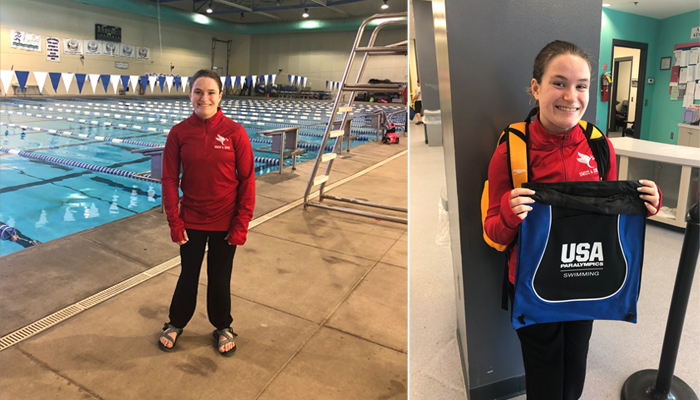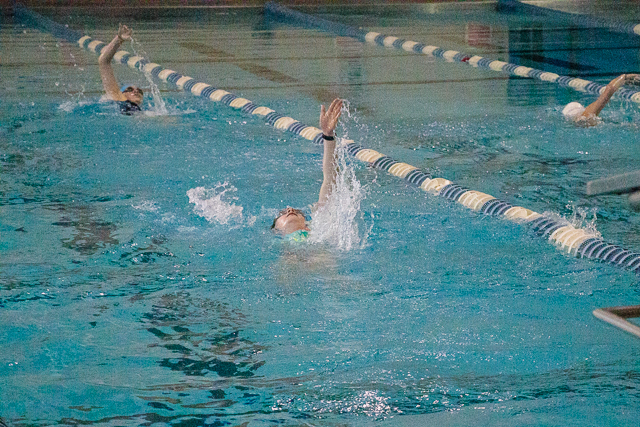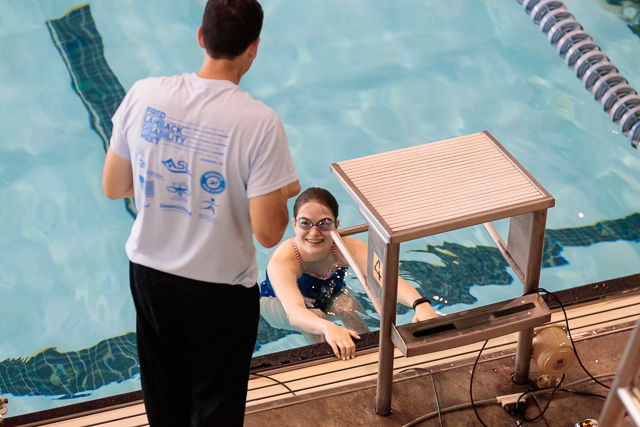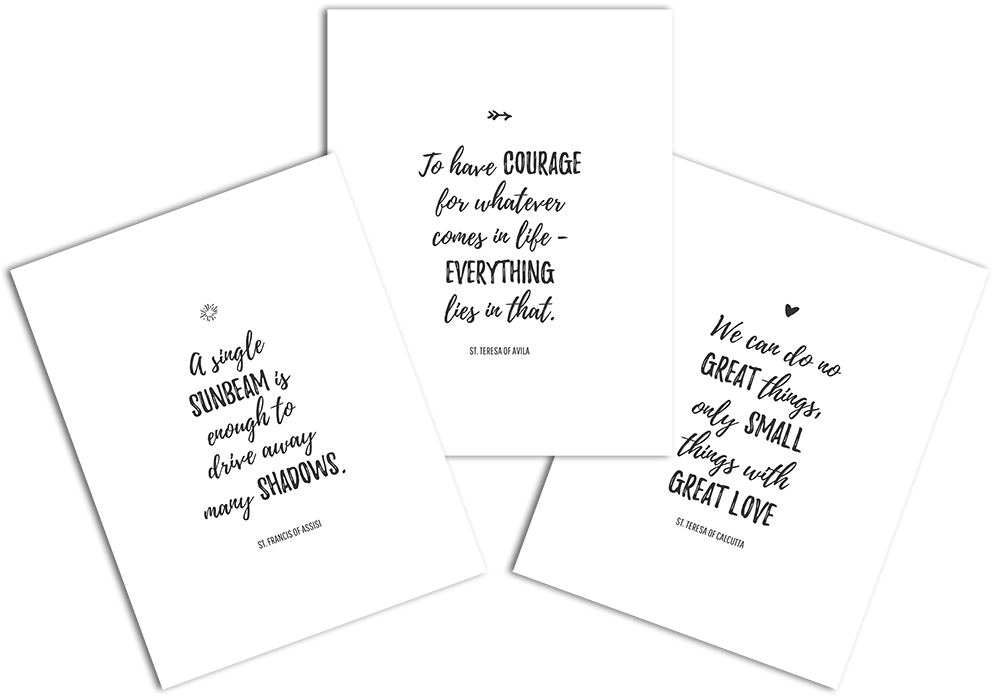
Sarah Kate walked through the doors of the aquatics center just ahead of me. She paused, turned to me, and said, “These are my people.” I smiled, happy to see that she was enthusiastic about this road trip we’d chosen to undertake. What I didn’t realize at the time was what a profound and accurate statement it was, and how true it would be for me, as well.
We had left home in the pre-dawn hours on a Thursday to drive eight hours to Augusta, Georgia, for the 7th Annual Fred Lamback Disability Meet – her first competition exclusively for swimmers with disabilities. She has been following the US Paralympic Team for awhile and we both thought she might be competitive in a meet with similarly impaired swimmers. She occasionally finishes ahead of an able-bodied swimmer here, but it’s rare. To our delight, US Paralympics was also conducting a development camp for a handful of swimmers prior to the meet; Sarah Kate applied and was accepted into the camp.
Development Camp Day 1
The camp started off with a “get to know you” session between the swimmers and the coaches. One of the questions Sarah Kate was given to answer was “Who is your favorite swimmer?” She didn’t hesitate, naming Cortney Jordan, a 12-time medalist on the US Paralympic Team who has cerebral palsy. After the opening session, the swimmers headed for the pool, and the parents and coaches who had traveled with their swimmers gathered on the bleachers and began to make small talk.
I happened to sit down near some other parents who also had teenage swimmers with cerebral palsy. We started out with the usual pleasantries – where we were from, what our swimmer’s name was, what our swimmer’s disability was – and when we realized how similar our backgrounds were our chatter became more animated. There was a “lightbulb moment,” marked by a slight pause in our conversation, when we looked at each other and all seemed to realize at once: this conversation isn’t like the hundreds of conversations about our kids that we’ve had with other people, because we all Get It.

Meanwhile, over in the pool, the swimmers were working two or three per lane, beginning with freestyle and backstroke. I noticed right away that the coaches were pushing Sarah Kate to do a wall or block start. She’s been starting in the water for awhile now – ever since she hurt her knee a few years ago when she caught her toe on the side – and I knew she wasn’t going to like it. Sure enough, at the end of the first session, she was in tears. They were working her hard, but that’s why we were there.
Development Camp Day 2
The second training session was on Friday morning. She was feeling better about things, and it went well. Following the morning session, the Team USA coaches (and McClain Hermes, a member of the US Paralympic team who is only two years older than Sarah Kate) led a Q&A session with the swimmers and their coaches and parents covering the athlete pipeline for US Paralympics Swimming. I felt like a fish out of water (see what I did there?) because Sarah Kate has only been competing in summer league and high school meets, not with USA Swimming on a club team. We did learn a lot, though, and – most helpfully – figured out who to call when we have questions or need information.
After lunch, the swimmers returned to the pool for their third and final session. I noticed right away that Sarah Kate had been moved to a different lane and paired with a different swimmer to work on breaststroke. Since it happened to be the last lane of the pool, I walked around to the side to observe. Coach Fred Lamback was assisting the Team USA coaches and right after Sarah Kate finished one length of breaststroke, he walked by me and said, “Watch this!” She began another length of breaststroke, this time only bringing her head up out of the water on about every fourth stroke. I knew without checking the clock that she was faster – a LOT faster. One tiny change to her technique dropped her 50 yard time from 1:17 to 1:07. When the Friday afternoon session ended, there were no tears, only a giant grin.

Following the afternoon training session, the swimmers and coaches gathered together one last time to talk about what they had learned, discuss moving forward, and – as a last team building exercise – tell the group what their favorite thing about the camp had been. McClain Hermes said her favorite thing was talking with and getting to know Sarah Kate. ❤️
Paralympic Classification
Sarah Kate’s classification appointment was at the end of the day on Friday. Paraswimmers are classified based on their level of impairment – not type of disability – and compete against other athletes in the same class, so a swimmer with cerebral palsy might swim against an amputee, a person with short stature, or someone with a spinal cord injury (all of those conditions were represented in Augusta, FYI) Classes 1-10 are for physical impairment and classes 11-13 are for visual impairment. Think of it like weight classes in boxing: in the same way a heavyweight doesn’t fight a lightweight, a blind swimmer doesn’t compete against a double amputee.
The classification was performed by a two-person team – one with a medical background and the other with a swimming background – and consisted of three phases: a physical evaluation, a technical evaluation, and observation during competition. For the physical evaluation, we provided copies of Sarah Kate’s medical records from her rehab doctors and the team took a number of measurements of her flexibility and strength. For the technical evaluation, the team observed her perform various swimming strokes and movements in the water. She was given a provisional classification on Friday; after observing her compete during the meet the classification was confirmed.
Sarah Kate was classified as an S7/SB6/SM7. “S” is the classification for freestyle, backstroke, and butterfly; “SB” is for breaststroke; “SM” is for individual medley. Breaststroke is classified separately because the mechanics are very different from the other strokes, requiring more power from the legs. Because we had been following paraswimming for awhile and had done a good deal of research, the S7/SM7 class was what we had expected, but the SB6 was a surprise. Between the stroke technique changes the coaches had recommended earlier that afternoon and the lower class than we had anticipated, it dawned on us that maybe breaststroke wasn’t her weakest stroke, as she’d always believed.

I love following the adventure of your family. Go SK!!!
Absolutely LOVE this!! Was so blessed to meet you, Sarah Kate, and so many other moms and swimmer! Can’t wait to see you again!!! We’ll have to compare this upcoming year’s schedule once it comes out.
YES! I have come back to that statement she made so many times since we came back home – the swimmers were her people, but the moms were my people! Hope to see you again in 2019!